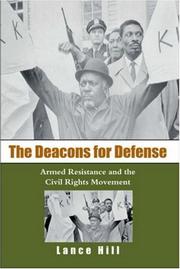| Listing 1 - 3 of 3 |
Sort by
|
Book
ISBN: 0520072634 Year: 1991 Publisher: Berkeley Los Angeles Oxford University of California Press
Abstract | Keywords | Export | Availability | Bookmark
 Loading...
Loading...Choose an application
- Reference Manager
- EndNote
- RefWorks (Direct export to RefWorks)
Ku Klux Klan --- History --- Women of the Ku Klux Klan --- Indiana
Book
ISBN: 0774824913 0774824905 0774824891 Year: 2013 Publisher: Vancouver : ©2013 UBC Press,
Abstract | Keywords | Export | Availability | Bookmark
 Loading...
Loading...Choose an application
- Reference Manager
- EndNote
- RefWorks (Direct export to RefWorks)
This provocative book provides a new interpretation of the Ku Klux Klan in 1920s Saskatchewan, arguing that it should not be portrayed merely as an irrational outburst of intolerance but as a slightly more extreme version of mainstream opinion that wanted to keep Canada British.
Racism --- History --- Ku Klux Klan (1915-) --- Saskatchewan --- Race relations --- Bias, Racial --- Race bias --- Race prejudice --- Racial bias --- Prejudices --- Anti-racism --- Critical race theory --- Knights of the Ku Klux Klan (1915- ) --- K.K.K. (Ku Klux Klan (1915- )) --- KKK (Ku Klux Klan (1915- )) --- K.K.K.K. (Knights of the Ku Klux Klan (1915- )) --- KKKK (Knights of the Ku Klux Klan (1915- )) --- National Knights of the Ku Klux Klan Association of America --- National Knights of the K.K.K. --- Invisible Empire --- Ku Klux Klan (19th century) --- Saskachevan --- Saskatchewan Government --- Government of Saskatchewan --- SK --- Sask. --- Social conditions

ISBN: 0807863602 9780807863602 9780807857021 9780807828472 0807828475 0807857025 9798890872098 Year: 2004 Publisher: Chapel Hill London
Abstract | Keywords | Export | Availability | Bookmark
 Loading...
Loading...Choose an application
- Reference Manager
- EndNote
- RefWorks (Direct export to RefWorks)
In 1964 a small group of African American men in Jonesboro, Louisiana, defied the nonviolence policy of the mainstream civil rights movement and formed an armed self-defense organization--the Deacons for Defense and Justice--to protect movement workers from vigilante and police violence. With their largest and most famous chapter at the center of a bloody campaign in the Ku Klux Klan stronghold of Bogalusa, Louisiana, the Deacons became a popular symbol of the growing frustration with Martin Luther King Jr.'s nonviolent strategy and a rallying point for a militant working-class movement in the South.Lance Hill offers the first detailed history of the Deacons for Defense and Justice, who grew to several hundred members and twenty-one chapters in the Deep South and led some of the most successful local campaigns in the civil rights movement. In his analysis of this important yet long-overlooked organization, Hill challenges what he calls'the myth of nonviolence--the idea that a united civil rights movement achieved its goals through nonviolent direct action led by middle-class and religious leaders. In contrast, Hill constructs a compelling historical narrative of a working-class armed self-defense movement that defied the entrenched nonviolent leadership and played a crucial role in compelling the federal government to neutralize the Klan and uphold civil rights and liberties.
African American civil rights workers --- Self-defense --- Political violence --- African Americans --- Civil rights movements --- Afro-Americans --- Black Americans --- Colored people (United States) --- Negroes --- Africans --- Ethnology --- Blacks --- Violence --- Political crimes and offenses --- Terrorism --- Hand-to-hand fighting --- Martial arts --- Afro-American civil rights workers --- Civil rights workers, African American --- Civil rights workers --- History --- Political aspects --- Civil rights --- Black people --- Deacons for Defense and Justice --- Ku Klux Klan (1915- ) --- History. --- Southern States --- Louisiana --- Mississippi --- Race relations. --- Knights of the Ku Klux Klan (1915- ) --- K.K.K. (Ku Klux Klan (1915- )) --- KKK (Ku Klux Klan (1915- )) --- K.K.K.K. (Knights of the Ku Klux Klan (1915- )) --- KKKK (Knights of the Ku Klux Klan (1915- )) --- National Knights of the Ku Klux Klan Association of America --- National Knights of the K.K.K. --- Invisible Empire --- Ku Klux Klan (19th century) --- J & D Club --- Jonesboro Legal and Defense Association --- Justice and Defense Club --- Louisiana (Province) --- Louisiana (Territory) --- Louisiane --- État de Louisiane --- Léta de la Lwizyàn --- Lwizyàn --- State of Louisiana --- US-LA --- La. --- Louisianne --- Territory of Louisiana --- District of Louisiana --- Luisiana --- West Florida --- Territory of Orleans
| Listing 1 - 3 of 3 |
Sort by
|

 Search
Search Feedback
Feedback About UniCat
About UniCat  Help
Help News
News